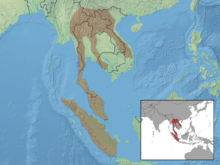Big bamboo rat
| Big bamboo rat | ||||||||||||
|---|---|---|---|---|---|---|---|---|---|---|---|---|

Large bamboo rat ( Rhizomys sumatrensis , stuffed specimen) |
||||||||||||
| Systematics | ||||||||||||
|
||||||||||||
| Scientific name | ||||||||||||
| Rhizomys sumatrensis | ||||||||||||
| ( Raffles , 1821) |
The large bamboo rat ( Rhizomys sumatrensis ), also Sumatran bamboo rat or Malay root rat , is a rodent from the genus of bamboo rats ( Rhizomys ). It occurs in large parts of Southeast Asia from the south of the Chinese province of Yunnan to the Malay Peninsula and Sumatra .
features
The large bamboo rat reaches a head-trunk length of 38.1 to 48.0 centimeters with a tail of 14.1 to 19.2 centimeters in length and a weight of about 2150 to 4000 grams. The rear foot length is 50 to 68 millimeters, the ear length 25 to 28 millimeters. It is the largest and heaviest species of the genus. The back fur and the sides of the body are light brown and interspersed with coarse feeler hair. The top and sides of the head are reddish brown, on the forehead, darker hair forms a dark triangle. The abdomen is only slightly lighter in color than the sides of the body, but the hair is very thin and the skin of the abdomen is visible. The tail is relatively long and hairless with a pink tip. The feet are large and have strong claws, the two front balls of the toes have grown together to form a joint ball.
| 1 | · | 0 | · | 0 | · | 3 | = 16 |
The skull reaches a length of 80 to 88 millimeters. It is large and strong and has a very strong zygomatic arch . The forehead crest (sagittal crest) is very high and strongly pronounced. The animals have like other Spalacidae maxillary per half an an incisor tooth trained incisors (incisive) to which a tooth gap ( diastema follows). This is followed by three molars , premolars missing. In total, they have a set of 16 teeth. The upper incisors are large and protruding. The first upper molar is slightly smaller than the following one.
The animals have a diploid chromosome set of 2n = 50 chromosomes.
distribution
The large bamboo rat occurs in large parts of Southeast Asia from the south of the Chinese province of Yunnan via Myanmar , Vietnam , Cambodia , Laos and Thailand to the Malay Peninsula and Sumatra . The altitude distribution ranges from about 1000 to about 4000 meters.
Way of life
The big bamboo rat lives mainly in bamboo forests with soft soils.
The animals live solitary in burrows that they dig into the ground. The burrows are comparatively short with a length of about 9 meters, they reach down to about a meter in depth. They have one to six entrances, which are marked and recognizable by large heaps of earth. They feed primarily on bamboo roots, leaves and sprouts that they look for above ground, and they probably also climb into the bamboo plants. In addition, there are other available parts of plants, regionally also agricultural plants. By rubbing their incisors together, the animals generate loud, grinding noises, and grunts are also documented.
Reproduction takes place twice a year, in February to April and in August to October. The gestation period lasts 22 days and the litters usually consist of three to five young animals that are born nestled. The lifespan of the animals is up to four years.
Systematics

The large bamboo rat is classified as an independent species within the genus of bamboo rats ( Rhizomys ), which consists of three species. The first scientific description comes from the naturalist and later founder of the city of Singapore Thomas Stamford Raffles from 1821, who described the species on the basis of individuals from the area around Malacca on the Malay Peninsula . The populations grouped under this species are probably not one species, but a species complex made up of several closely related species.
Status, threat and protection
The large bamboo rat is classified as Least Concern by the International Union for Conservation of Nature and Natural Resources (IUCN). This is justified with the very large distribution area and the assumed large populations of the species. If there are actually several species, a reassessment is necessary. In parts of the distribution area the species is used and hunted as a source of meat.
supporting documents
- ↑ a b c d e f g h i Andrew T. Smith: Large Bamboo Rat. In: Andrew T. Smith , Yan Xie: A Guide to the Mammals of China. Princeton University Press, Princeton NJ 2008, ISBN 978-0-691-09984-2 , p. 214.
- ↑ Andrew T. Smith: Family Spalacidae. In: Andrew T. Smith , Yan Xie: A Guide to the Mammals of China. Princeton University Press, Princeton NJ 2008, ISBN 978-0-691-09984-2 , p. 209.
- ↑ a b c d e Rhizomys sumatrensis in the IUCN Red List of Threatened Species 2015.4. Posted by: K. Aplin, D. Lunde, 2008. Retrieved July 23, 2016.
- ^ John Anderson : Anatomical and Zoological Researches: comprising an account of the Zoological results of the two expeditions to Western Yunnan in 1868 and 1875. Bernard Quaritch, London 1878.
- ↑ Rhizomys sumatrensis . In: Don E. Wilson , DeeAnn M. Reeder (Eds.): Mammal Species of the World. A taxonomic and geographic Reference. 2 volumes. 3. Edition. Johns Hopkins University Press, Baltimore MD 2005, ISBN 0-8018-8221-4 .
literature
- Andrew T. Smith: Large Bamboo Council. In: Andrew T. Smith , Yan Xie: A Guide to the Mammals of China. Princeton University Press, Princeton NJ 2008, ISBN 978-0-691-09984-2 , p. 214.
Web links
- Rhizomys sumatrensis inthe IUCN Red List of Threatened Species 2015.4. Posted by: K. Aplin, D. Lunde, 2008. Retrieved July 23, 2016.
